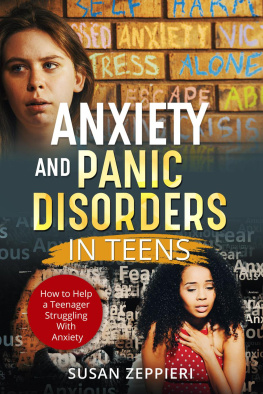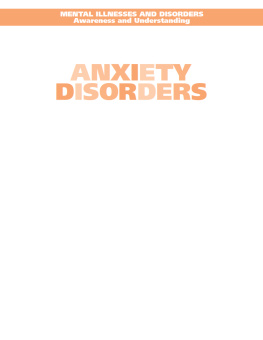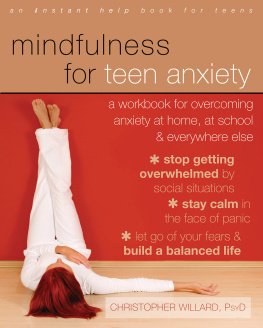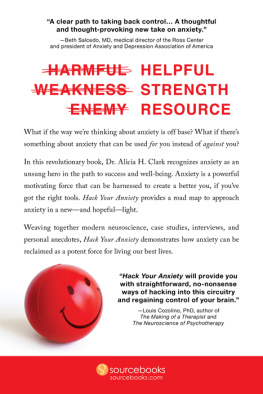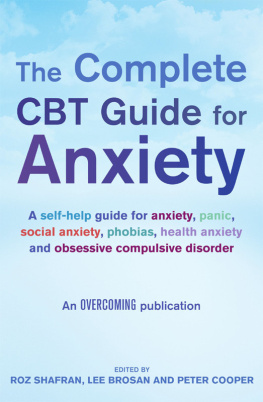Anxiety and Panic Disorders in Teens How to Help a Teenager Struggling With Anxiety
Susan Zeppieri
Published by Susan Zeppieri, 2021.
While every precaution has been taken in the preparation of this book, the publisher assumes no responsibility for errors or omissions, or for damages resulting from the use of the information contained herein.
ANXIETY AND PANIC DISORDERS IN TEENS HOW TO HELP A TEENAGER STRUGGLING WITH ANXIETY
First edition. September 12, 2021.
Copyright 2021 Susan Zeppieri.
ISBN: 979-8201172473
Written by Susan Zeppieri.
10 9 8 7 6 5 4 3 2 1
Book Description
The teenage years can be some of the most confusing and disruptive years of our lives. With rising pressures from social, academic, and employment demands, it is no wonder that anxiety in teenagers has doubled in the last decade, with 1 in 3 teenagers in America now struggling with anxiety related disorders.
Whether youre a parent, guardian, teacher, or just a concerned friend, it can be hard to know where to start if you want to offer support to a teen who might be struggling on their own.
Throughout this book, we offer insights to the causes of anxiety and how to spot it in others, all the way through to how you can help someone set up their own wellness plan, and help them navigate this difficult time in their lives.
Anxiety and Panic Disorders in Teens
How to Help a Teenager Struggling With Anxiety
Susan Zeppieri
Copyright 2021 - All rights reserved.
The content contained within this book may not be reproduced, duplicated or transmitted without direct written permission from the author or the publisher.
Under no circumstances will any blame or legal responsibility be held against the publisher, or author, for any damages, reparation, or monetary loss due to the information contained within this book, either directly or indirectly.
Legal Notice:
This book is copyright protected. It is only for personal use. You cannot amend, distribute, sell, use, quote or paraphrase any part, or the content within this book, without the consent of the author or publisher.
Disclaimer Notice:
Please note the information contained within this document is for educational and entertainment purposes only. All effort has been executed to present accurate, up to date, reliable, complete information. No warranties of any kind are declared or implied. Readers acknowledge that the author is not engaged in the rendering of legal, financial, medical or professional advice. The content within this book has been derived from various sources. Please consult a licensed professional before attempting any techniques outlined in this book.
By reading this document, the reader agrees that under no circumstances is the author responsible for any losses, direct or indirect, that are incurred as a result of the use of the information contained within this document, including, but not limited to, errors, omissions, or inaccuracies.
Table of Contents
A nnually, up to 11 % of Americans will experience a panic attack, with some 3% of this group going on to develop a panic disorder from these experiences (Panic Disorder & Panic Attacks | Cleveland Clinic, 2018). Sadly, these figures are even higher when looking at how teenagers are affected by anxiety and panic disorders. It is reported that nearly 1 in 3 teenagers between the ages of 13 to 18 will experience an anxiety disorder (McCarthy, 2019). Within the last decade, this figure has doubled, as have hospital admissions for suicidal teenagers.
With as few as 20% of teenagers actually receiving treatment for their anxiety, this leaves 80% without. The treatment for these disorders could be a matter of getting an adolescent to a counsellor to help with cognitive behavioural therapies and, bearing this in mind, the fact that so many teenagers are left without medical support in these instances is a sad reflection on how far this particular condition has been allowed to slip. Bearing in mind, though, that the average cost of a session with a counsellor sits in the realm of $65 to $150 per hour without insurance (Fraga, 2018). This cost falls well outside what a teenager may be able to afford if they dont feel like theyre in a position to confide in an adult who can help them. There are free and low income mental health services available in some states, but some teenagers face further judgement for seeking out these options. Unfortunately, in so far as stigmas are concerned, they work in a vicious cycle. Many adolescents need additional support and are either scared of reaching out, or cannot afford to do so.
What can we do to help this, though? It might seem like the teenager in question isnt responding well to attempts made so far to attempt to help them, and if that is the case, then it may be necessary to take a different approach. How can we work better to help teens all over to feel safe enough to speak up when they are in distress?
The answers lie in how we approach and interact with teenagers. Throughout this book, we will explore the reasons teens face these disorders and what we can do to help lift them out of these positions and support them.
Whether its something small that needs a little bit of tweaking, or an entire re-evaluation of whats happening, throughout the following chapters, we will be exploring how best to interact with your teenagers and what they might need in terms of additional support.
While the following pages are packed full of information about anxiety, depression, and what can be done to help ease it, it is always important to remember that not every case is identical. Communicating with the teenager in question is particularly important as it will give you insights into what theyre experiencing and how they can be helped. This should manifest itself as a collaboration between you and the teenager youre trying to support through their difficulties.
Chapter 1: What Are Anxiety and Panic Disorders?
A nxiety and panic disorders are widely known about, however, the more integral details of these disorders are less well understood. As a result, it can be increasingly difficult to know if the person youre trying to support is suffering with one of these disorders due to the multitude of information available to us, only some of which is relevant.
Taking a closer look at these disorders can present a clearer picture from which to work, and provide you with some insight on the situation your teenager might find themselves in.

